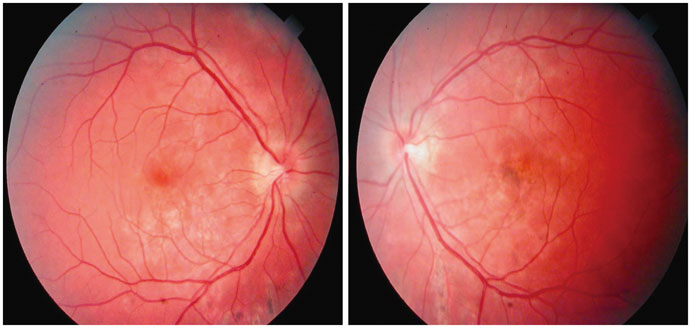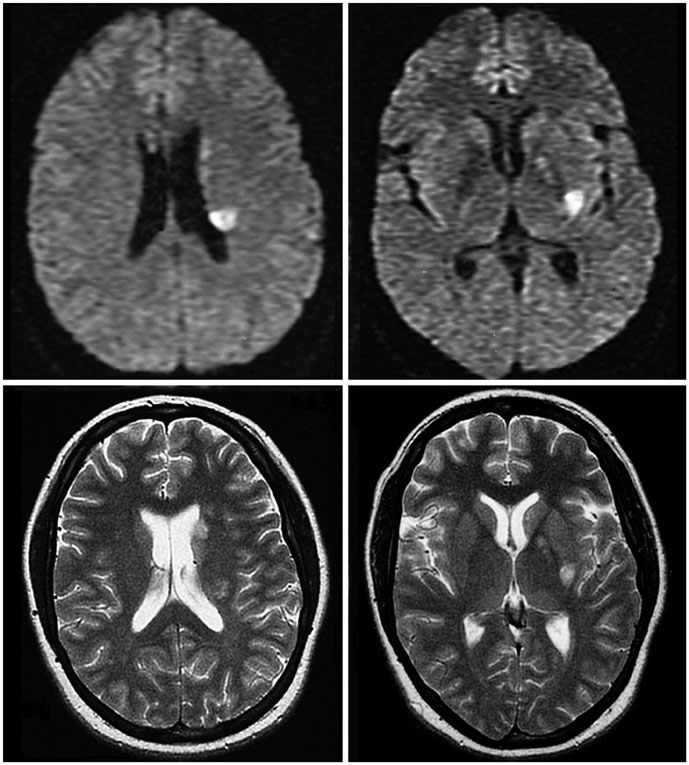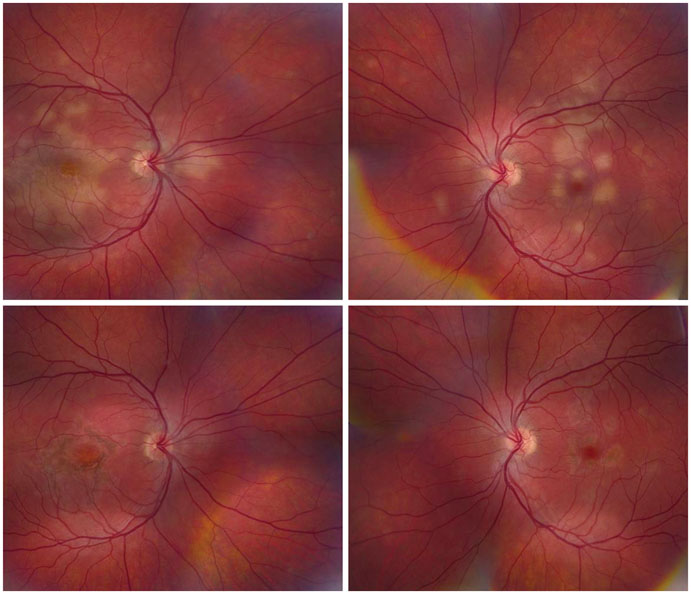J Clin Neurol.
2016 Oct;12(4):460-467. 10.3988/jcn.2016.12.4.460.
Neurological Manifestations of Acute Posterior Multifocal Placoid Pigment Epitheliopathy
- Affiliations
-
- 1King Abdulaziz Medical City/King Saud bin Abdulaziz University for Health Sciences, Jeddah, Saudi Arabia. halgahtani@hotmail.com
- 2King Abdullah International Medical Research Center/King Saud bin Abdulaziz University for Health Sciences, Jeddah, Saudi Arabia.
- KMID: 2385111
- DOI: http://doi.org/10.3988/jcn.2016.12.4.460
Abstract
- BACKGROUND AND PURPOSE
Acute posterior multifocal placoid pigment epitheliopathy (APMPPE) is an immune-mediated chorioretinal disease that causes acute visual symptoms with characteristic ophthalmoscopic findings. Neurological complications are rarely reported in the literature. Here we report two new cases of APMPPE that presented with neurological manifestations, one of which was associated with peripheral neuropathy, which has not been described before.
METHODS
A retrospective database review of all patients with a diagnosis of APMPPE was performed. Clinical, ophthalmological, and neurological data were analyzed, and only cases of APMPPE with neurological complications were included. A literature review of several databases was also performed, and previous case reports were reviewed and analyzed in detail.
RESULTS
In total, 56 cases of APMPPE-associated neurological complications were included in the analyses: 54 from the literature and 2 from our own practice. The most common complication was cerebral vasculitis, which affected 28 patients (50%), followed by headaches in 15 patients (26.8%). The other complications include sixth-cranial-nerve palsy, transient hearing loss, meningoencephalitis, cavernous sinus thrombosis, and viral meningitis.
CONCLUSIONS
This report adds to the literature of a novel association of APMPPE with peripheral neuropathy, and comprehensively reviews the neurological manifestations of this disease. A high level of suspicion should be applied when dealing with a case of APMPPE. We recommend applying detailed clinical neurological examinations and magnetic resonance imaging to APMPPE patients, and then early steroid treatment if the examination is positive or even suspicious. Early treatment with steroids and long-term treatment with immunosuppressive azathioprine with interval neurological evaluations will contribute positively to the outcomes and avoid fatal complications, namely strokes.
Keyword
MeSH Terms
-
Adrenal Cortex Hormones
Azathioprine
Cavernous Sinus Thrombosis
Diagnosis
Headache
Hearing Loss
Humans
Magnetic Resonance Imaging
Meningitis, Viral
Meningoencephalitis
Neurologic Examination
Neurologic Manifestations*
Paralysis
Peripheral Nervous System Diseases
Retrospective Studies
Steroids
Stroke
Vasculitis, Central Nervous System
Adrenal Cortex Hormones
Azathioprine
Steroids
Figure
Reference
-
1. Vianna RN, Socci D, Nehemy MB, Deschênes J, Burnier MN Jr. The white dot syndromes. Arq Bras Oftalmol. 2007; 70:554–562.
Article2. Case D, Seinfeld J, Kumpe D, Folzenlogen Z, Jones W, Simpson J, et al. Acute posterior multifocal placoid pigment epitheliopathy associated with stroke: a case report and review of the literature. J Stroke Cerebrovasc Dis. 2015; 24:e295–e302.
Article3. Gass JD. Acute posterior multifocal placoid pigment epitheliopathy. Arch Ophthalmol. 1968; 80:177–185.
Article4. Deutman AF, Oosterhuis JA, Boen-Tan TN, Aan de Kerk AL. Acute posterior multifocal placoid pigment epitheliopathy. Pigment epitheliopathy of choriocapillaritis? Br J Ophthalmol. 1972; 56:863–874.
Article5. Holt WS, Regan CD, Trempe C. Acute posterior multifocal placoid pigment epitheliopathy. Am J Ophthalmol. 1976; 81:403–412.
Article6. Oleszczuk JD, Saeed MU. Neurological symptoms associated with acute multifocal placoid pigment epitheliopathy: treatment dilemma and diagnostic issues. Semin Ophthalmol. 2015; 30:238–240.
Article7. Roberts TV, Mitchell P. Acute posterior multifocal placoid pigment epitheliopathy: a long-term study. Aust N Z J Ophthalmol. 1997; 25:277–281.
Article8. Luneau K, Newman NJ, Srivastava S, Biousse V. A case of acute posterior multifocal placoid pigment epitheliopathy with recurrent stroke. J Neuroophthalmol. 2009; 29:111–118.
Article9. Bouchenaki N, Cimino L, Auer C, Tao Tran V, Herbort CP. Assessment and classification of choroidal vasculitis in posterior uveitis using indocyanine green angiography. Klin Monbl Augenheilkd. 2002; 219:243–249.
Article10. Di Crecchio L, Parodi MB, Saviano S, Ravalico G. Acute posterior multifocal placoid pigment epitheliopathy and ulcerative colitis: a possible association. Acta Ophthalmol Scand. 2001; 79:319–321.
Article11. Darugar A, Mathian A, Lehoang P, Bodaghi B. Acute posterior multifocal placoid pigment epitheliopathy as the initial manifestation of sarcoidosis. J Ophthalmic Vis Res. 2011; 6:338–343.12. Thomson SP, Roxburgh ST. Acute posterior multifocal placoid pigment epitheliopathy associated with adenovirus infection. Eye (Lond). 2003; 17:542–544.
Article13. Azar P Jr, Gohd RS, Waltman D, Gitter KA. Acute posterior multifocal placoid pigment epitheliopathy associated with an adenovirus type 5 infection. Am J Ophthalmol. 1975; 80:1003–1005.
Article14. Brézin AP, Massin-Korobelnik P, Boudin M, Gaudric A, LeHoang P. Acute posterior multifocal placoid pigment epitheliopathy after hepatitis B vaccine. Arch Ophthalmol. 1995; 113:297–300.
Article15. Fine HF, Kim E, Flynn TE, Gomes NL, Chang S. Acute posterior multifocal placoid pigment epitheliopathy following varicella vaccination. Br J Ophthalmol. 2010; 94:282–283. 363
Article16. Wolf MD, Folk JC, Panknen CA, Goeken NE. HLA-B7 and HLA-DR2 antigens and acute posterior multifocal placoid pigment epitheliopathy. Arch Ophthalmol. 1990; 108:698–700.
Article17. Hsu CT, Harlan JB, Goldberg MF, Dunn JP. Acute posterior multifocal placoid pigment epitheliopathy associated with a systemic necrotizing vasculitis. Retina. 2003; 23:64–68.
Article18. Reichhart M. Acute posterior multifocal placoid pigment epitheliopathy (APMPPE). In : Caplan LR, Bogousslavsky J, editors. Uncommon causes of stroke. 2nd ed. Cambridge: Cambridge University Press;2008. p. 237–246.19. Tsang BK, Chauhan DS, Haward R, Whiteman I, Frayne J, McLean C. Fatal ischemic stroke complicating acute multifocal placoid pigment epitheliopathy: histopathological findings. J Neuroophthalmol. 2014; 34:10–15.
Article20. Clearkin LG, Hung SO. Acute posterior multifocal placoid pigment epitheliopathy associated with transient hearing loss. Trans Ophthalmol Soc U K. 1983; 103(Pt 5):562–564.21. Kersten DH, Lessell S, Carlow TJ. Acute posterior multifocal placoid pigment epitheliopathy and late-onset meningo-encephalitis. Ophthalmology. 1987; 94:393–396.
Article22. Kline DC, Vitale A, Warner JE. Acute multifocal placoid pigment epitheliopathy associated with cavernous sinus thrombosis. Ocul Immunol Inflamm. 2007; 15:443–446.
Article23. Gibelalde A, Bidaguren A, Ostolaza JI, Cortázar L, Irigoyen C. [Pigmentary epitheliopathy multifocal acute placoid associated with paralysis of VI cranial par]. Arch Soc Esp Oftalmol. 2009; 84:159–162.24. Thomas BC, Jacobi C, Korporal M, Becker MD, Wildemann B, Mackensen F. Ocular outcome and frequency of neurological manifestations in patients with acute posterior multifocal placoid pigment epitheliopathy (APMPPE). J Ophthalmic Inflamm Infect. 2012; 2:125–131.
Article25. O'Halloran HS, Berger JR, Lee WB, Robertson DM, Giovannini JA, Krohel GB, et al. Acute multifocal placoid pigment epitheliopathy and central nervous system involvement: nine new cases and a review of the literature. Ophthalmology. 2001; 108:861–868.26. Vianna R, van Egmond J, Priem H, Kestelyn P. Natural history and visual outcome in patients with APMPPE. Bull Soc Belge Ophtalmol. 1993; 248:73–76.27. Williams DF, Mieler WF. Long-term follow-up of acute multifocal posterior placoid pigment epitheliopathy. Br J Ophthalmol. 1989; 73:985–990.
Article28. Bridges WJ, Saadeh C, Gerald R. Acute posterior multifocal placoid pigment epitheliopathy in a patient with systemic-onset juvenile rheumatoid arthritis: treatment with cyclosporin A and prednisone. Arthritis Rheum. 1995; 38:446–447.
Article29. Weinstein JM, Bresnick GH, Bell CL, Roschmann RA, Brooks BR, Strother CM. Acute posterior multifocal placoid pigment epitheliopathy associated with cerebral vasculitis. J Clin Neuroophthalmol. 1988; 8:195–201.30. Stoll G, Reiners K, Schwartz A, Kaup FG, Althaus C, Freund HJ. Acute posterior multifocal placoid pigment epitheliopathy with cerebral involvement. J Neurol Neurosurg Psychiatry. 1991; 54:77–79.
Article31. Comu S, Verstraeten T, Rinkoff JS, Busis NA. Neurological manifestations of acute posterior multifocal placoid pigment epitheliopathy. Stroke. 1996; 27:996–1001.
Article32. Wilson CA, Choromokos EA, Sheppard R. Acute posterior multifocal placoid pigment epitheliopathy and cerebral vasculitis. Arch Ophthalmol. 1988; 106:796–800.
Article33. de Vries JJ, den Dunnen WF, Timmerman EA, Kruithof IG, De Keyser J. Acute posterior multifocal placoid pigment epitheliopathy with cerebral vasculitis: a multisystem granulomatous disease. Arch Ophthalmol. 2006; 124:910–913.
Article
- Full Text Links
- Actions
-
Cited
- CITED
-
- Close
- Share
- Similar articles
-
- A Case of Acute Posterior Multifocal Placoid Pigment Epitheliopathy, Associated with Bilateral Serous Retinal Detachment
- A Case of Acute Posterior Multlfocal Placoid Pigment Epithellopathy
- A Case of Acute Posterior Multifocal Placoid Pigment Epitheliopathy
- A Case of Acute Posterior Multifocal Placoid Pigment Epitheliopathy, Presenting with Bilateral Serous Retinal Detachment
- A Case of Acute Posterior Multifocal Placoid Pigment Epitheliopathy Following Human Papilloma Virus Vaccination




